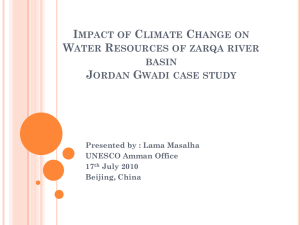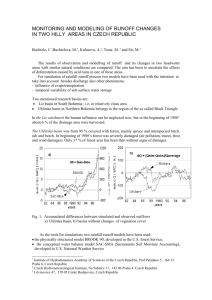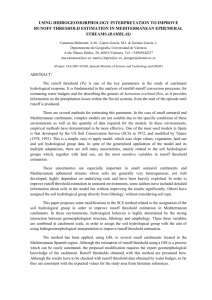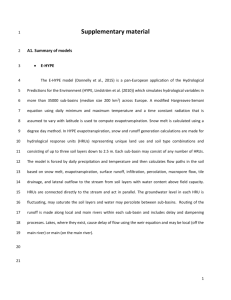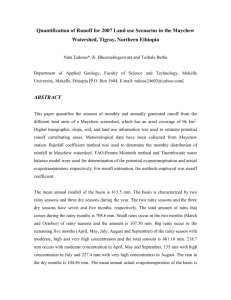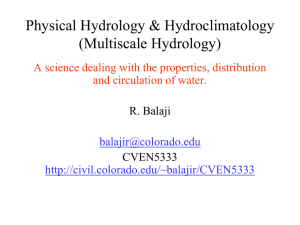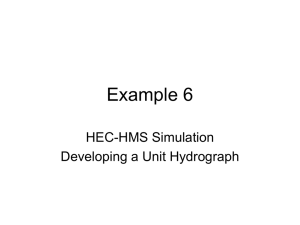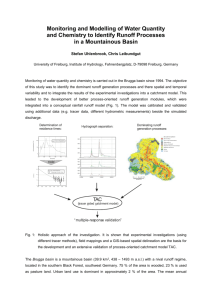- UNDP-ALM
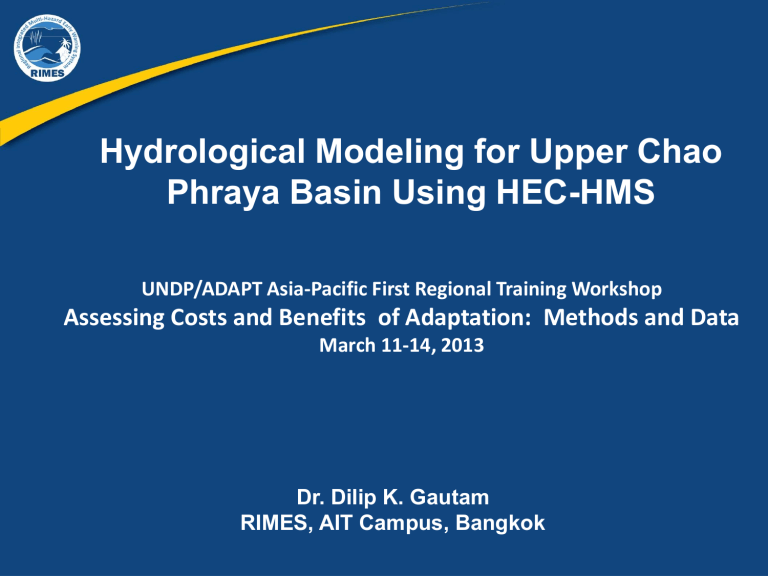
Hydrological Modeling for Upper Chao
Phraya Basin Using HEC-HMS
UNDP/ADAPT Asia-Pacific First Regional Training Workshop
Assessing Costs and Benefits of Adaptation: Methods and Data
March 11-14, 2013
Dr. Dilip K. Gautam
RIMES, AIT Campus, Bangkok
Hydrological Model
A model is a simplified representation of reality.
A mathematical model consists of series of equations defining the system we are dealing with. The function of model is to convert the given input into an output.
A hydrological model is the mathematical representation of the response of a catchment system to hydrologic events during the time period under consideration.
Hydrological phenomena are extremely complex, highly non-linear and highly variable in space and time.
A model is needed to predict the watershed runoff for the design and management of water resources utilization and flood control projects.
Classification of Hydrological Models
Hydrological Model Outputs for
Climate Change Impact Assessment
Simulated flow peaks, volumes and hydrographs at the outlets of subbasins and the points of special interest such as reservoirs, weirs or other hydraulic structures
Simulated long flow sequences for water budget and drought analyses
Simulated extent of flooded areas for different precipitation events and various antecedent basin conditions
Hydrologic processes that need to be captured by the model
Single-event precipitation-runoff transformation
Continuous precipitation-runoff transformation
Snow accumulation and melt
Interception, infiltration, soil moisture accounting
Evapotranspiration
Regulated reservoir operation
HEC-HMS
• US Army Corps of Engineers, Hydrologic Engineering
Center’s Hydrologic Modeling System software
• Designed to simulate both single event and continuous rainfallrunoff process
• Simulates precipitation-runoff and routing processes, both natural and controlled
• HEC-HMS uses a separate model to represent each component of the runoff process including:
runoff volume;
direct runoff (overland flow and interflow);
baseflow;
channel routing.
HEC-HMS representation of watershed runoff
Key Components of Model
Runoff Volume models: separate infiltration from pervious surface, runoff from impervious surface, compute the direct runoff volume
Direct Runoff models: transform direct runoff volume from excess precipitation into fast component of flow
Base Flow models: compute slow subsurface drainage component
Routing models: compute flow attenuation and translation over channel
Reservoir models: flow regulation
Data Required
Digital Elevation Model (DEM), land use, soil types and other physiographic data
Precipitation, temperature data
Evaporation/evapotranspiration data
Discharge, Water level and Rating curve data
Channel and reservoir hydraulic data
Generated sequence of meteorological data representing various scenarios of future climate
Upper Chao
Phraya Basin,
Thailand
Catchment Area
= 105553 sq. km.
Dams and Reservoirs
Bhumibol dam in the Ping River (Storage 13462 MCM)
Sirikit dam in the Nan River (Storage 9510 MCM)
Kwae Noi dam in Kwae Noi River (Storage 766 MCM)
Kiew Kor Mha dam in Wang River (Storage 171 MCM)
Kiew Lom dam in Wang River (Storage 112 MCM)
Data preparation using HEC-GeoHMS
Delineate catchment and river network
Obtain catchment characteristics data (area, slope etc)
Make Thiessen polygon
Obtain Thiessen weights
Prepare basin file
Data preparation using HEC-DSSVue
Time series data (rainfall, discharge etc.)
Pair data (elevation-storage)
Model Setup
Basin model
Meteorological model
Time series data
Pair data
Control specification
Meteorologic model
Precipitation
Evapotranspiration
Snowmelt : not applicable for upper Chao Phraya
Precipitation methods
Gauge weights : selected for upper Chao Phraya
Inverse distance
Gridded precipitation
Frequency storm
SCS storm
Specified Hyetograph
Standard project storm
Evapotranspiration methods
Monthly Average : selected for upper Chao Phraya
Priestley-Taylor
Gridded Priestley-Taylor
Snowmelt methods
Gridded temperature index
Temperature index
Control Specifications
Simulation start date/time
Simulation end date/time
Time interval
Model Calibration
Finding optimal parameter values
Minimizing difference between simulated flow and observed flow
Objective functions
Peak weighted RMS error
Percent error peak
Percent error volume
RMS log error
Sum of absolute residuals
Sum of squared residuals
Time weighted error
Search Algorithms
Nelder Mead
Univariate Gradient
The Basin Model
Simulated Hydrograph at Basin Outlet
R2 = 0.71
BIAS = 6.7 % NS = 0.71
Conclusions
Semi-distributed physically based deterministic hydrological models are powerful tools for assessing climate change impact on water resources.
Continuous modeling approach could be taken to assess the impact on flow volume.
Care should be taken to interpret the results as there are lots of uncertainties in the model inputs, parameters and structure of the model. Uncertainties associated with climate models will also be carried over.
Thank You !
Dr. Dilip K. Gautam, Senior Hydrologist, RIMES
E-mail: dilip.gautam@rimes.int
Website: www.rimes.int

